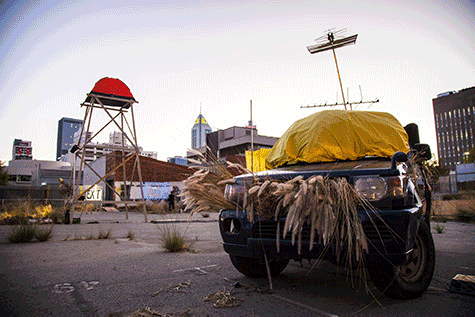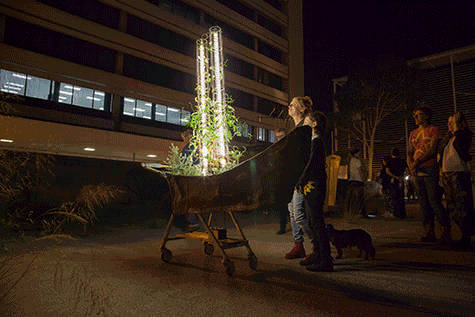Road rage art
Darren Jorgensen: Rumblestrip

Rumblestrip
photos Yvonne Doherty
Rumblestrip
In the 1960s artists stopped making objects for galleries and arranged events in alleyways, houses and parks. Instead of artworks and exhibitions, there were environments and happenings. It didn’t take long for the gallery to hook artists back into the system with two catchy concepts. These were the curator and the installation, which would happily accommodate the new, expanded ambitions of artists to create experiences rather than artworks. The visual arts have been all the poorer since the 1960s, as artists aspire to secure a place in exhibition programs, rather than to change the world.
This was not so for one night in Perth recently, as the artists of Rumblestrip, a post-apocalyptic amalgamation of brutalist vehicles, ethereal projections and strange objects, created a total outdoor environment, a crowded happening that was also something of a poke in the eye for Perth’s flashy new city developments. With the surrealism of Mulholland Drive and the kitsch of Mad Max: Beyond Thunderdome, the survivalism of Waterworld and the ridiculousness of Wolf Creek 2, Rumblestrip was an immersion in everything that is both dangerous and wrong about Australia: its obsession with vehicles, its love of a loud, drunken party, its long night drives through the bush.
It makes little sense to distinguish here between one artwork and another, the hotted-up Hilux hybridised with a Wacky Waving Inflatable Arm Flailing Tube Man from the endless sunset projected onto the side of a nearby building. For the one-night event was more than each of its elements, echoing with the maddening sounds of engines revving, car doors creaking and mechanical tapping. There was a lot of aluminium foil and a few tarpaulins, a towering wooden scaffold and survivalist trolleys of appetising green plants. There was a swamp and a rogue pushmobile that inspired road rage in its drivers.

Rumblestrip
photos Yvonne Doherty
Rumblestrip
Rumblestrip simulated a chaos that has long been missing in the hyper-organised events that Perth usually hosts for its law-abiding public. The recent audio-visual spectacle that opened the Perth Festival was nauseatingly sentimental about suburban life. Called Home, it had one foot firmly in the 1960s, and recreated a fantasy of Perth as a sleepy, beach-going country town. Rumblestrip was a dystopian answer to Home, capturing instead the city’s current predicament, dominated by roads and endless development. Time in today’s city is no longer spent on the beach or in the backyard, but with a foot on the accelerator navigating the sprawl.
The hundreds who turned up to Rumblestrip proved that there is an appetite in Australia for conceptual fun, for a visual arts scene that is also a party, and for a party that is also an artwork. Audience members were able to recognise their own hallucinations in the specular glow of in-vehicle installations and the amorphous shapes that dotted the space. Rumblestrip touched the raw nerve of automobility, the flash of anger and thrust of acceleration that comes after being cut off, or nearly run down.
–
Rumblestrip, concept Neil Aldum, Erin Coates, Simone Johnston, featured artworks by Erin Coates, Shaun Gladwell, Loren Holmes, Stuart James, Simone Johnston, Jack Sargeant, Snapcat; Northbridge, Perth, 5 March
RealTime issue #131 Feb-March 2016, web






